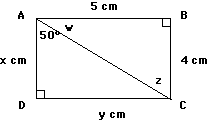These properties can then be used to find missing information about quadrilaterals.
|
Example 1
|
Example 2
|
|
|
 |
| ABCD is a rectangle. Find the size of the angles and sides marked by letters. Give reasons. |
ABCD is a parallelogram.
|
|
w + 50 = 90 (angles in a rectangle are 90°) z = 50° (alternate angles on parallel lines) x = 4 cm (opposite sides of rectangle are equal) y = 5 cm (opposite sides of rectangle are equal)
|
x = 5.7 cm (opposite sides of a parallelogram) a = 40° (opposite angles of parallelogram) b = 46° (alternate angles on paralllel lines)
|




